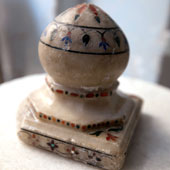Design Resource
Jaipur Stone Carving
The Skillful Crafts in Stone
by
Prof. Bibhudutta Baral,Anisha Crasto and Anushree Kumar
People:
Artisans from various communities come across to practice this ancient craft. Earlier a large number of Muslim communities were involved only in carving intricate patterns on the fort and palaces whereas the sculpting was done by the Brahmins due to their religious significance. The Brahmins were regarded as the progenies of Atri Rishi. They were believed to be blessed to sculpt fine idols of god and goddess. Today artisans from all communities Hindu, Muslim, Sikh, Baniya and Kumawat work together as a community and help in growing this craft. Still the majority of artisans engaged in producing the idols belong to Sharma and Prajapati cast. Other cast people are involved in other work. There are around four to five thousand stone carvers dwelling in these lanes. These artisan groups apart from practicing the craft also have a welfare society where they contribute a part of their income which goes in the education, health and other social activities of the society.
Place:
Rajasthan has a very old history of stone carving. The state is filled with number of places having huge deposits of rocks. The major region for rock deposits are Makrana, Mount Abu, Amba Ji, Kota, Bidasar, Jodhpur, Jaisalmar, Udaipur, Jaipur, Sikandra, Alwar, etc. These places have high quality rocks which are famous all over the world. Makrana is the main centre for quarrying all types of marbles and it is also renowned for producing the finest and the whitest quality of marble. These regions are also full of proficient stone carvers and clusters. The Maharaja of Jaipur Sawai Jai Singh gave place to some of the highly skilled artisans in the walled city. This place was called as Silawaton ka Mohalla. Later with the increase in number of the artisans the lanes expanded and now the hub of stone carvers is called as Khazane Walon Ka Rasta. Apart from this the artisans have also spread in other parts around the city due to lack of place and increasing health problems caused by the stone dust.









